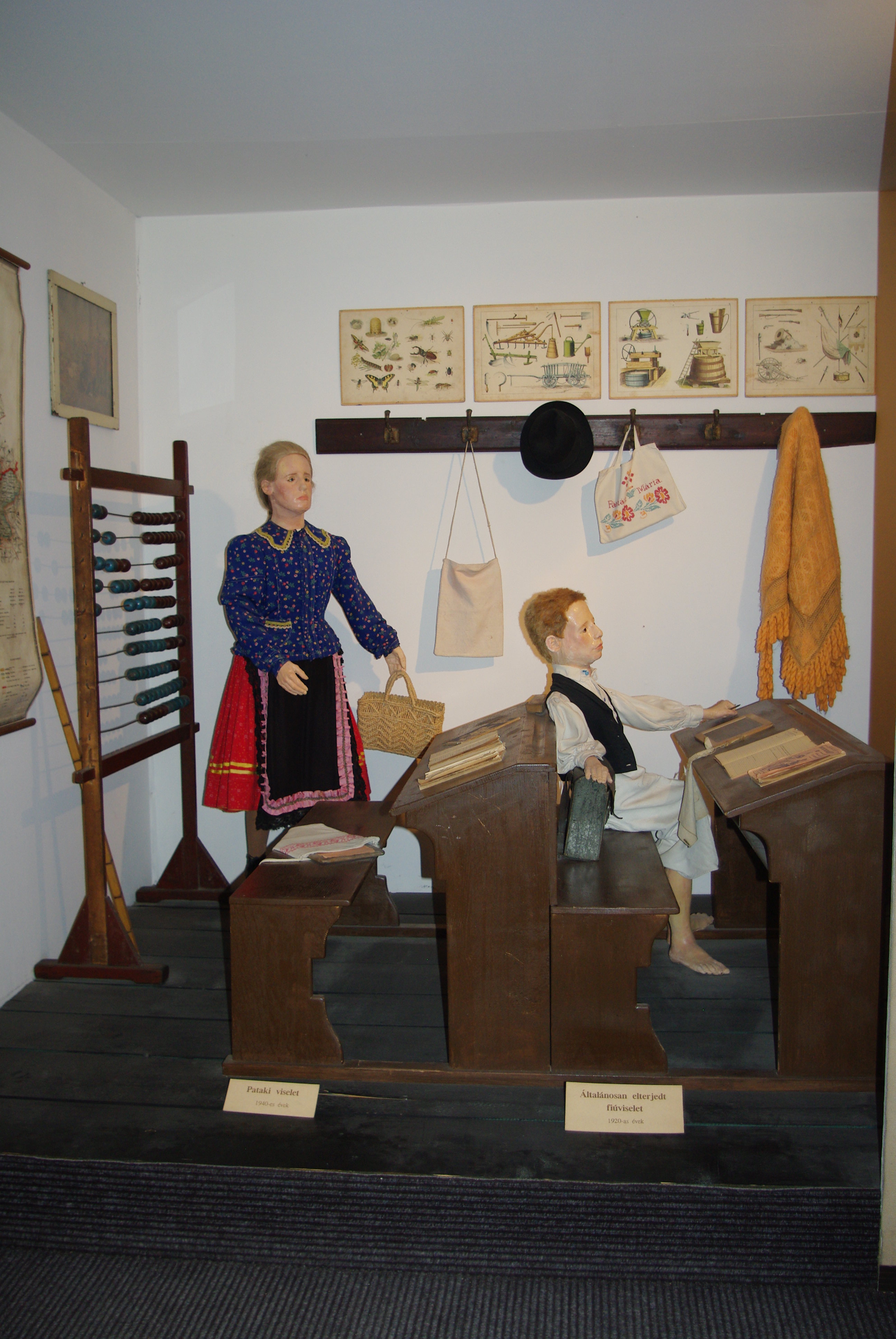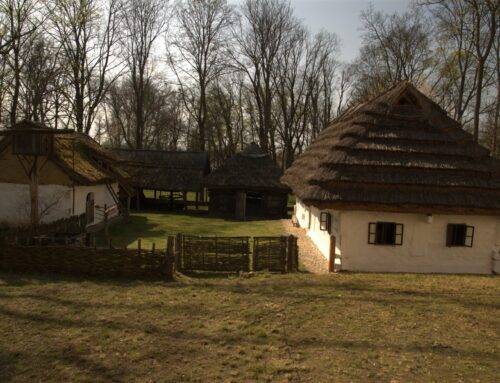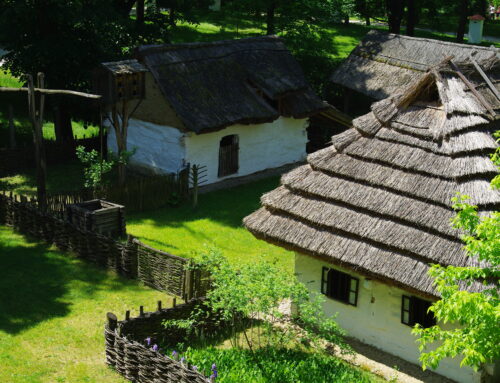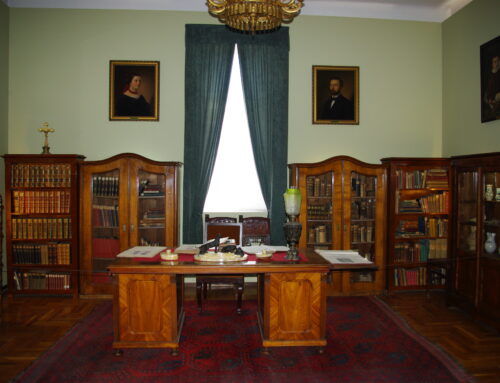A kiállítás az elmúlt 100-120 év paraszti életformájáról ad áttekintést. A kedvezőtlen természeti adottságok, a történeti, társadalmi körülmények sajátos alakulása korlátozta az itt élők lehetőségeit. A környék parasztságának életmódja, kultúrája tehát lassabban változott, s számos régies vonást örökített át századunkra.
A gyermekáldásban Isten akaratát látták megtestesülni. A gyermekágy körül főleg tapasztalt, idősebb asszonyok tevékenykedtek, ez kedvezett a hagyományok továbbélésének. A néphit szerint az újszülöttre számos veszedelem leselkedik: ezeket mágikus eljárásokkal igyekeztek elhárítani.
A rövid gyermekágyas időszak elteltével a család élete visszatért a rendes kerékvágásba. Az idősebb testvéreket korán bevonták a kicsik felügyeletébe, gondozásába, s ha lábra kapott az apróság, ment ő is a gyermekhaddal játszani. Az intézményes neveltetés egy részét viszont az iskola jelentette. Az otthonról hozott vallási indíttatás is az iskolás kortól kapott intézményes keretet.
A mulatságok, ünnepi szokások vidám forgatagában szövődtek a szerelmi kapcsolatok. Azonban a házassággal kapcsolatosan a fiatalok érzelmei háttérbe szorultak: a szülő szava döntött, gyakorlatias szempontok alapján. A házasságkötés szokáskörének csúcspontja a lakodalom, amelynek révén, mint egy tudatták a közösséggel a nagy eseményt. Megrendezése alkalmul szolgált a reprezentációra, lehetőséget teremtvén az akár három napig eltartó evés-iváshoz, vidám mulatozáshoz.
A házasság révén a menyecske bekerült férje családjába. A 19-20. század fordulóján még fellelhetők voltak palócvidéken az ún. nagycsaládok. A módosabb réteg körében élő családforma mellett az egyszerű vagy kiscsaládok voltak többségben. Mindkét forma keretei között alapvetően megváltozott a fiatalok élete, újfajta elvárásoknak kellett megfelelniük.
A hétköznapok megfeszített munkájában a vasárnapok békés hangulata jelentett feloldást. A közvasárnapok sorából kiemelkedtek az egyházi év jelentős alkalmai, a templom szentelésének évfordulója ill. védőszentjének ünnepe. A katolikusoknál nagy jelentőségű volt a búcsújárás is.
Az évek múlását vidékünkön szemléletesen fejezte ki a nők viseletének fokozatos változása, ami a cifrálkodás háttérbe szorulásában és az öltözködés rendjének egyszerűsödésében nyilvánult meg.
A sublótfiókban összekészítve állt a “halóruha” s mindazon kellékek, amikre majd “akkor” lesz szükség. A halál a paraszti felfogás szerint nem a megsemmisülést jelenti, hanem az emberi lét misztikus átalakulását. A túlvilági életbe vetett hit napjainkig fenntartotta a halottlátó intézményét.The permanent exhibition, which was opened on the centennial of the foundation of the Palóc Museum in 1891, draws its theme from the rich folk traditions in the region. In order to evoke the world of peasants, the exhibitors chose an approach from the aspect of customs and traditions. The three most important transitions in human life – birth, marriage and death – constitute the main pillars of the exhibition whereupon the different phases of life are displayed. In the presentation of the rich and manifold themes, photographs play an important role, which at the same time help understand the exhibited works of art. In the exhibition following the human lifecycle, the various significant traditions, customs, and their parts, become virtually alive through up-to-date objects and puppets clothed according to the style of the period. The exhibition spans the period from the last third of the nineteenth century till the 1960’s. The process of serfdom emancipation lagged behind the national development. The unfortunate natural conditions, the distinctive societal-historical circumstances (property relations, late industrial development etc.) narrowed the possibilities of the people living in the area. Poverty was accompanied by a more conservative mentality. All this jointly contributed in a way to the fact that the way of life and the culture of the peasants in this region only gradually changed and thereby retained several archaic features into the twentieth century. This is valid for the (mainly Evangelic) Slovaks moving in among the (Catholic) Hungarians after the Turkish rule, and partly for the (Catholic) Germans as well, even though among the latter two ethnic groups segregation contributed to the maintenance of their own traditions.
Birth
The peasantry in our region saw the blessing of a child as an incarnation of the will of God. Only the older, more experienced women took part in childbearing and the care of birth, which helped the transmission of traditions. According to popular belief numerous perils lurked upon the new-born babies. It was mostly feared that witches in the cover of the night would swap their own malformed cripples for the healthy children. That was to be prevented, it was believed, through hanging the so-called tent over the bed – this is illustrated in one of the room interiors of the twentieth century. The tent sheet was one of the most decorated items of the trousseau of the girls; the selection of some of those displayed in the showcases demonstrates the variety of ornamentation in the textile culture of Nógrád. There were numerous other courses of action to keep the evil spirits away from the children. Among the objects against imprecation, we find consecrated objects, which mostly offer help against the evil eye.
The community cared for the woman in confinement, as long as she had to stay in bed, at which the godmother took over the provision for the former with hot meals and drinks. The custom called poszrik (baptismal feast) was different in its elements according to various areas and times.
Within a week, the christening of the child took place. Through the church ceremony the child took its place in the congregation. The closest relatives celebrated the event with a great feast, which at the same time implied the acceptance of the little newcomer in the family and the community. Long before the birth of the child the godparents were searched out, often amongst the friends of the youth. God parentage was a close and mutual undertaking that lasted for life – it bound the godparents to the child for the rest of its life – furthermore, it was accompanied by the generous giving of presents for the christening.
The presentation of the godparent going to church illuminates a special local custom. The christening quilt made of several decorated headscarves would result, according to popular belief, in that the child would be “desired” when it reached marriageable age. The time on the morrow of the birth turned into a scene of various magical activities and wizardry that could have an influence on the child’s development and future.
Infancy and Childhood
After the short period of confinement, the family’s life fell back into the old groove. The so called children’s furniture (cradle, child’s seat, various traditional baby-walkers) are objects of child-care, the use of which sometimes can be traced back to medieval times. In the peasant’s way of life the mother had but little time for her small child – circumstances that led to obtaining these objects. Very early the older children were called in to watch over and take care of their younger siblings, who as soon as they could stand on their own feet, joined the flocks of playing children. The garden and the street, and later the fields, offered plenty of opportunities for playing games. The imaginative toys were made of material and things of the prevailing surroundings. Most of the toys served as means of copying the world and activities of the grown-ups. As the child grew older, it took part in the family’s work according to its abilities. As participant of the common games and folk customs, it acquired by and by the rules of the social life. This way it gathered a lot of experience and knowledge, which were necessary for adult life.
Institutionalised upbringing on the one hand was embodied in the school. In the exhibition, the atmosphere of a village school is illustrated by an extraction of an interior from the time between the World Wars. Often the family’s economical activities compelled the children to neglect education. In the schooldays religious grounding brought from home were put into an institutionalised framework. First communion and then confirmation were important milestones in the development of the child’s faith. On these occasions the child received abundant gifts from the godparents. Among the Lutherans similar customs were usual at confirmation.
Time of Youth
Confirmation meant the beginning of youth at the same time. Among Catholics, a girl counted as grown-up when she ended her education, which was also represented in the way she dressed. The boys became first youngsters at the same time. Later on, as their work could be considered equivalent to that of the grow-ups, they joined the ranks of the lads through an initiation ceremony at the pub. The lad associations were responsible for the organisation of festivities and various convivial occasions. These were joined by the similar, more intimate groups of girls. Beside the traditional communities, various other associations, organized by the church or the state, worked as well during the 20th century. In our region, there was a group among Catholics called Mary Congregation. The richly coloured costumes of the Mary-girls and flag-carrying lads belonged, and do so still today, to the formalities of church holidays and processions, at which the members of these groups have to fulfil certain tasks.
In the cheerful bustle of the festivities and celebrations many love affairs evolved. Courting had a traditional form and the community watched over the behaviour of the young people. The expression of feelings – even within the frames of the customs – was only possible in a symbolic way, as the so-called love gifts displayed here show.
Wedding
As the time of marriage approached, the feelings of the young people were pushed to the background. The choice of marriage partner was decided by the parents based on practical reasons. The content of marriage in peasant society is complex and significant. For married couples these obligations were meant for a lifetime, and through this they stepped from youth into adulthood, into the age group of the married. This step affected their whole life. This also gave the legal possibility to beget off-springs. Marriage also united the relatives of the young couple, which could have had great social impact.
The peak of marriage customs was reached with the wedding, through which the event was practically announced. The organisation of the wedding offered above all the parents of the bride the possibility to representation and, at the same time, assured three-four days of eating and drinking. The wedding required not only a lot of money but also careful planning. With the latter, the different office holders of the wedding helped both of the families. Among them the godfathers of the bride and the bridegroom played the most important role, as well as the best man, who performed the festive customs. The wedding dignitaries wore special signs – the best man had a spontoon with small ribbons and a small bridal wreath on the chest.
The activities of a wedding were put together in different ways, which varied according to nationality, area or the economical status of the families of the bridal couple. The desire to organize a beautiful and memorable wedding feast offered an opportunity, besides the traditional rites, to introduce innovations as well. From this line of activities, the exhibited photo captures the moment as the wedding guests arrive to the house of the groom, and the mother of the groom receives the bridal couple with honey, so that their life will be sweet. Superstitious customs aimed at the benefaction of the future of the young couple were attached to this point of passage in the lifecycle as well.
In the exhibition an outfit of a nicely made bed can be seen, and a filled cupboard as well, which shows the trousseau of an average peasant girl in the 1930’s. The size of the trousseau changed through time and depended on the economic status of the families involved. The bridal trousseau was brought to the house of the bridegroom, where it was publicly displayed, through the rite of carrying the bed, which in a sense served as a prelude for the wedding. The so-called cake of joy, represented here by two variants, is one of the most spectacular features of a wedding. These were a gift from the godmother and their consumption was carried out among ritual circumstances.
Adulthood
Through marriage, the young wife became part of her husband’s family. At the turn of the nineteenth to the twentieth century, the so-called extended families came into existence among the Palóc people. The extended family, living under one roof, was made up of three or four generations. All family members were working under the leadership of the master of the house. This form remained long alive among the more prosperous strata of the society, but the majority of the younger people sooner or later left home and lived within the frames of a nuclear or a small family, consisting of the husband and wife and their children.
In both forms, the lives of the newly married people changed fundamentally as they had to fulfil new expectations. The greater part of the peasant’s working activities can be divided into two groups according to sex, which is also indicated by the separation of the exhibited objects. The house served as a framework for female activities. Besides child rearing, it was keeping the house in order, cooking and bread baking, watching out for the small livestock, and working with hemp, which counted as more typical female work. Tasks that generally required more physical strength – like sowing, threshing, all sorts work with a yoke, and rearing the livestock – were considered male responsibilities. For the carrying out of these duties more space was needed. The distribution of the separate tasks depended on the form of the family.
The natural succession of the seasons presented the framework for the course of the peasant’s work. Certain tasks were connected to a specific calendar day. One of the most important feasts of the year was that of the harvest. At the entrance of the exhibition there is a wall calendar that describes in detail how the different economical activities and the feasts are distributed through the year.
The produced surplus of products, as well as of animals, was offered for sale at small farmers’ markets or at the bigger yearly markets. At those markets or in the small special shops in the towns that met the demands of the peasants, necessary tools, clothes and handicraft products for the household were obtained at the same time. The isolation of a village has always been relative, but above all during the last two centuries there was a close connection between village and town. The church, the manor and the intellectuals of the village played a significant role as intermediary of culture; among the men the military service had a similar importance. The head of the community, the chosen magistrate, acted as a two-way intermediary toward the state. The symbol of his office was a richly ornamented staff.
At the end of the arduous workdays, the tranquil atmosphere of the Sunday provided a relief. One prepared oneself thoroughly, both spiritually and physically, for the Sunday mass. After the mass and devotion at the church, as well as after the richer meal, there was enough time for amusement with relatives or neighbours or to visit the wine cellars.
Out of the row of ordinary Sundays, special religious feasts stood out. The exhibition shows here the customs around Christmas, Easter and Whitsun. Besides their religious contents, several superstitious acts were connected to these holidays. The magical directions or proscriptions were aimed against evil forces and at ensuring fertility, health and good fortune. Good examples are the customs around the Christmas table. One of the greater feasts among the Palóc is the so called “visiting”-feast. This is in fact the feast of the village patron to which not only relatives from nearby were invited, but also those from regions further away were welcome. At these celebrations, women wore their most ornamented and expensive clothes during the great mass. The interior showing young women coming out of the church also gives an impression of the rich variety of the costumes of the Palóc.
Among Catholics, pilgrimage had an extraordinary role. The relics from Mátraverebély-Szentkút, a holy place known nation-wide, deserved a special place in the exhibition as well. Beside this, there are other places for pilgrimage of local importance, and it was even usual to visit places outside the border of Hungary, shown on the maps displayed. Pilgrimage served to keep the mental and physical health of the living and the salvation of the souls of the dead.
Pilgrimage had a regionally and ethnically varying traditional structure, to which many customs were attached. The water of a well of a holy place was believed to possess healing powers. Votive object made of wax were chosen according to the wishes and goals of the pilgrims. Among the Palóc, richly ornamented pilgrimage bags were common, in which they brought presents for those who stayed at home. Small house altars made of the small statues and pictures of devotion, and had the archaic name Mary-house.
Old Age
The slow passage of years were visible in the clothing of women – there was less ornamentation, the colours became darker and the dress itself simpler. As time went by, the children grew up, grandchildren and great grandchildren were born. Even if the family did not live together, greater economic activities were done collectively; only leadership and the division of the activities may have changed. The old parents worked hard – till the limits of their strength and health. After their work was not needed anymore, they spent most of their time with the children of the family and strived to pass on their knowledge to them. Religion and the world of the church became gradually more important for them; they prepared themselves for the great turning point of their lives. Many of them used to, and still do, prepare their death clothes long before their death, the matching clothes for the great journey, the mortuary shroud, the crucifix, the Bible and all the other things that was considered necessary.
Death and the Time After
According to popular belief, death did not mean annihilation, but a transformation, through which the living step from the life on earth into the life beyond. The customs around death are compounded by the teachings of Christian religion and of archaic superstitions. These customs are still alive, on one hand because of fear of death, on the other because of respect for death.
In the centre of the customs around death are the needs of the living to separate and keep away the dead from the community. This has a practical reason as well, to secure the soul’s way to the beyond, to ensure the tranquillity of the dead. The rituals also provide a framework that makes the farewell easier for the relatives.
The shape of the grave signs reflects the religious affiliation of the dead. Especially the grave signs carved of one log, found in Catholic graveyards in the area of Karancs, are worth to be mentioned. Masterpieces of skilled stonemasons served as models for these finely worked out, baroque style and relief decorated crosses. The grave signs of Lutherans were of a simple style.
Mourning expressed the respect for the memory of the dead. Rules for behaviour and clothing were in the first place a concern of the female relatives. The family took care of their dead after the mourning period as well – their graves were well maintained, at the anniversary of their death a mass was held for the salvation of their souls. The belief in the life beyond kept necromancers busy up till present time. These persons with supernatural power intermediated between the dead and the relatives who wished to get into contact with them.




